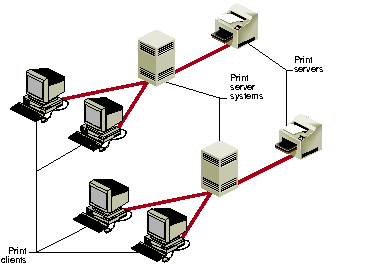
Note: The utilities described in this section, mkcentpr, mkserialpr, mkscsipr, and mknetpr, should be used whenever possible. For a list of supported printers, see the directory /var/spool/lp/model. Additionally, these utilities list the printers they support when they are executed.
The special file /dev/plp is the interface to the parallel printer port. Some larger servers and workstations have multiple parallel ports. There is one parallel port on each IO4 board on CHALLENGE and Onyx systems.
If you have more than one parallel port on your system, the device files that refer to the ports are named according to the board slot in which the CPU board is installed. For example, if you have an IO4 board in slot 2 and another in slot 4, the device files for the parallel ports are /dev/plp2 and /dev/plp4. One of these devices (the parallel port attached to the board designated as the primary board) is linked to the default /dev/plp.
Normally, /dev/plp is directly accessed only by a print spooling mechanism such as the lp subsystem. The special file /dev/plp may only be opened for writing by one process at a time. However, several processes may open the device in read-only mode to find out the printer status. A printer reset is issued whenever the device file is opened for writing. For a complete description of the parallel printer interface, see the plp(7) reference page.
Parallel and serial printers are installed with a similar procedure, but to different ports. Your printer hardware documentation should detail the cabling requirements for the printer's interface. For a complete description of both types of interfaces, see "Printer Cable Pin Signal Tables". Connect the printer interface cable to your printer and to the appropriate port on the back of your workstation.
To register printers connected directly to your computer via a parallel or serial port, follow these steps:
/usr/lib/lpshut
mkcentpr
The mkcentpr utility is an interactive script that prompts you for all necessary information about your printer and then automatically registers it. You should be prepared to specify the device file for the parallel port (/dev/plp unless you have multiple CPU boards installed) and other specific information. Consult the mkcentpr(1M) reference page for complete information about mkcentpr syntax.
mkserialpr
The mkserialpr command is similar to mkcentpr except that it is used for the serial port. Consult the mkserialpr(1M) reference page for complete information about mkserialpr syntax.
/usr/lib/lpadmin -dprinter-name
/usr/lib/lpsched

Figure 2-3 : Print Servers, Print Clients, and Print Server Systems Print servers must be configured on the print server system before remote clients can configure them successfully across the network.
To configure a print server for use across a network, follow these steps:
addclient client_name
addclient grants permission for the specified client_name to access print servers across the network.
Note: The addclient command allows anyone who has access to the lp account on the print client to have the privileges of the lp account on the print server system. This means that your lp system can be modified by the client system users.
If you want all remote workstations to be able to use print servers on the print server system, type:
addclient -a
/usr/lib/lpshut
mknetpr queue hostname printer-name
queue is the name of the printer queue and should be no more than 14 characters long. hostname is the name of the system acting as the print server system, and printer-name is the name by which the print server is known to users accessing it.
/usr/lib/lpadmin -dprinter-name
/usr/lib/lpsched